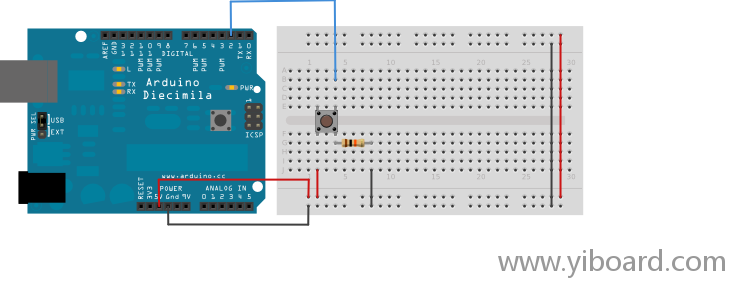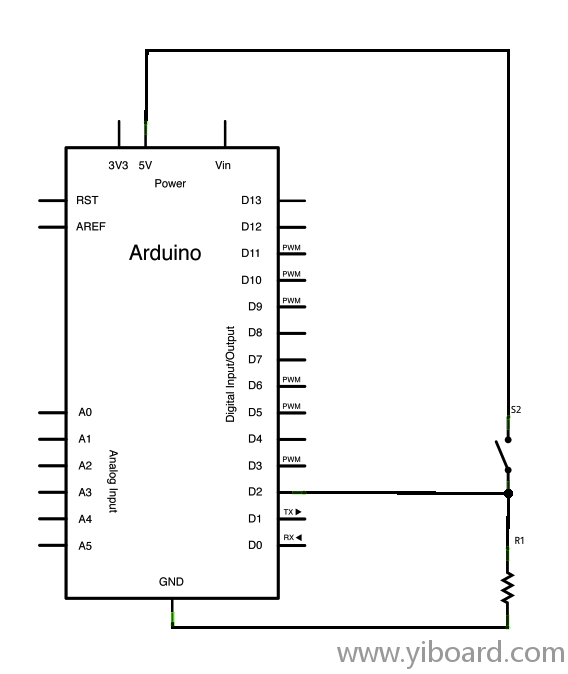|
按键防抖(Debounce) 按键在按下时,由于机械和物理特定的原因,经常会产生一些开关变换,而这些变换会让程序误认为是短时间内进行了多次按键。本示例展示了如何对输入信号进行防抖,也就是在一段短时间内进行两次检查来确保按键确实被按下。如果没有防抖的话,按下一次按键会产生很多不可预知的结果。示例代码使用了mills()函数记录按键按下经过的时间。
所需硬件 - Arduino或者Genuino开发板 - 按钮开关 - 10K电阻 - 导线 - 面包板
电路连接方式

原理图

代码 以下代码基于Limor Fried的防抖方法,但是逻辑与她的示例相反。她的示例中,按键在闭合时返回低电平LOW,断开时返回高电平HIGH。而在本例中,按键按下时返回高电平,未按下时返回低电平LOW。 - /*
- Debounce
- Each time the input pin goes from LOW to HIGH (e.g. because of a push-button
- press), the output pin is toggled from LOW to HIGH or HIGH to LOW. There's
- a minimum delay between toggles to debounce the circuit (i.e. to ignore
- noise).
- The circuit:
- * LED attached from pin 13 to ground
- * pushbutton attached from pin 2 to +5V
- * 10K resistor attached from pin 2 to ground
- * Note: On most Arduino boards, there is already an LED on the board
- connected to pin 13, so you don't need any extra components for this example.
- created 21 November 2006
- by David A. Mellis
- modified 30 Aug 2011
- by Limor Fried
- modified 28 Dec 2012
- by Mike Walters
- This example code is in the public domain.
- http://www.arduino.cc/en/Tutorial/Debounce
- */
- // constants won't change. They're used here to
- // set pin numbers:
- const int buttonPin = 2; // the number of the pushbutton pin
- const int ledPin = 13; // the number of the LED pin
- // Variables will change:
- int ledState = HIGH; // the current state of the output pin
- int buttonState; // the current reading from the input pin
- int lastButtonState = LOW; // the previous reading from the input pin
- // the following variables are long's because the time, measured in miliseconds,
- // will quickly become a bigger number than can be stored in an int.
- long lastDebounceTime = 0; // the last time the output pin was toggled
- long debounceDelay = 50; // the debounce time; increase if the output flickers
- void setup() {
- pinMode(buttonPin, INPUT);
- pinMode(ledPin, OUTPUT);
- // set initial LED state
- digitalWrite(ledPin, ledState);
- }
- void loop() {
- // read the state of the switch into a local variable:
- int reading = digitalRead(buttonPin);
- // check to see if you just pressed the button
- // (i.e. the input went from LOW to HIGH), and you've waited
- // long enough since the last press to ignore any noise:
- // If the switch changed, due to noise or pressing:
- if (reading != lastButtonState) {
- // reset the debouncing timer
- lastDebounceTime = millis();
- }
- if ((millis() - lastDebounceTime) > debounceDelay) {
- // whatever the reading is at, it's been there for longer
- // than the debounce delay, so take it as the actual current state:
- // if the button state has changed:
- if (reading != buttonState) {
- buttonState = reading;
- // only toggle the LED if the new button state is HIGH
- if (buttonState == HIGH) {
- ledState = !ledState;
- }
- }
- }
- // set the LED:
- digitalWrite(ledPin, ledState);
- // save the reading. Next time through the loop,
- // it'll be the lastButtonState:
- lastButtonState = reading;
- }
|